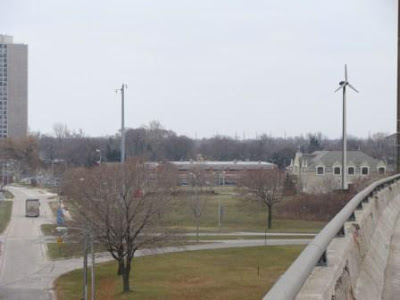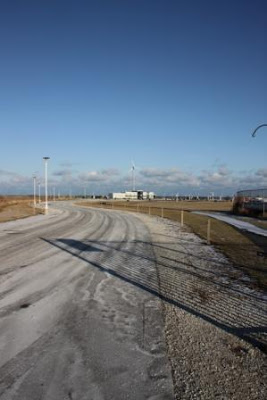by jboullion | Jan 14, 2011 | Uncategorized
From a news release issued by RENEW Wisconsin:
The window on new wind power developments is likely to slammed completely shut by the end of 2011 under a proposal released by Governor Scott Walker, according to RENEW Wisconsin, a statewide renewable energy advocacy organization.
“As part of a larger proposal ostensibly to create jobs, Governor Walker unveiled new restrictions on wind energy development that, if adopted by the Legislature, would drive development activity worth $1.8 billion out of state,” said Michael Vickerman, executive director of RENEW Wisconsin.
Governor Walker’s proposal would mandate minimum setbacks of 1,800 feet between a wind turbine and the nearest property line, a dramatic increase from the setback distance of 1,250 feet from a neighboring residence approved by the Public Service Commission in a rule that would otherwise take effect on March 1.
“There are very few locations in the entire Badger State that are windy and large enough, and located near transmission lines, to overcome such extreme constraints,” said Vickerman.
This setback requirement, which would be more stringent than any other statewide regulation in the nation, would also apply to permitted projects that have not begun construction, such as the two-turbine project in a Village of Cashton industrial park that was ready to begin construction this spring. A 99-megawatt project near Darlington in Lafayette County would also be blocked, said Vickerman.
“Because construction has commenced, We Energies’ 90-turbine Glacier Hills Wind Park in Columbia County will avoid these extreme restrictions,” said Vickerman. “Adoption of Walker’s proposal will draw the curtain on projects that would follow Glacier Hills, which will be able to power up to 45,000 homes.”
by jboullion | Jan 14, 2011 | Uncategorized
From a news release issued by RENEW Wisconsin:
The window on new wind power developments is likely to slammed completely shut by the end of 2011 under a proposal released by Governor Scott Walker, according to RENEW Wisconsin, a statewide renewable energy advocacy organization.
“As part of a larger proposal ostensibly to create jobs, Governor Walker unveiled new restrictions on wind energy development that, if adopted by the Legislature, would drive development activity worth $1.8 billion out of state,” said Michael Vickerman, executive director of RENEW Wisconsin.
Governor Walker’s proposal would mandate minimum setbacks of 1,800 feet between a wind turbine and the nearest property line, a dramatic increase from the setback distance of 1,250 feet from a neighboring residence approved by the Public Service Commission in a rule that would otherwise take effect on March 1.
“There are very few locations in the entire Badger State that are windy and large enough, and located near transmission lines, to overcome such extreme constraints,” said Vickerman.
This setback requirement, which would be more stringent than any other statewide regulation in the nation, would also apply to permitted projects that have not begun construction, such as the two-turbine project in a Village of Cashton industrial park that was ready to begin construction this spring. A 99-megawatt project near Darlington in Lafayette County would also be blocked, said Vickerman.
“Because construction has commenced, We Energies’ 90-turbine Glacier Hills Wind Park in Columbia County will avoid these extreme restrictions,” said Vickerman. “Adoption of Walker’s proposal will draw the curtain on projects that would follow Glacier Hills, which will be able to power up to 45,000 homes.”
by jboullion | Jan 14, 2011 | Uncategorized
From a news release issued by RENEW Wisconsin:
The window on new wind power developments is likely to slammed completely shut by the end of 2011 under a proposal released by Governor Scott Walker, according to RENEW Wisconsin, a statewide renewable energy advocacy organization.
“As part of a larger proposal ostensibly to create jobs, Governor Walker unveiled new restrictions on wind energy development that, if adopted by the Legislature, would drive development activity worth $1.8 billion out of state,” said Michael Vickerman, executive director of RENEW Wisconsin.
Governor Walker’s proposal would mandate minimum setbacks of 1,800 feet between a wind turbine and the nearest property line, a dramatic increase from the setback distance of 1,250 feet from a neighboring residence approved by the Public Service Commission in a rule that would otherwise take effect on March 1.
“There are very few locations in the entire Badger State that are windy and large enough, and located near transmission lines, to overcome such extreme constraints,” said Vickerman.
This setback requirement, which would be more stringent than any other statewide regulation in the nation, would also apply to permitted projects that have not begun construction, such as the two-turbine project in a Village of Cashton industrial park that was ready to begin construction this spring. A 99-megawatt project near Darlington in Lafayette County would also be blocked, said Vickerman.
“Because construction has commenced, We Energies’ 90-turbine Glacier Hills Wind Park in Columbia County will avoid these extreme restrictions,” said Vickerman. “Adoption of Walker’s proposal will draw the curtain on projects that would follow Glacier Hills, which will be able to power up to 45,000 homes.”
by jboullion | Jan 14, 2011 | Uncategorized
From an article by Tom Content in the Milwaukee Journal Sentinel:
More than 160 people got their first glimpse Thursday of what a city wind turbine development near the Port of Milwaukee would look like.
A packed house at the South Shore Park Pavilion took a look at the renderings. Some asked questions about the project, its cost, and the noise the turbines would generate, among other concerns.
The city’s Office of Environmental Sustainability is proposing the project to make a statement in support of renewable energy and to tap greener sources of electricity for the Port of Milwaukee’s administration building.
The turbines would be either 115 or 156 feet tall, depending on the model selected. That’s less than half as tall as the utility-scale turbines built in recent years by We Energies and Invenergy in Fond du Lac and Dodge counties.
Ken Szallai, president of the Lake Express Ferry, said the city should consider making a broader statement toward sustainability that could incorporate solar power and informational exhibits, potentially at the Lake Express terminal that the city owns.
He said he shares concerns about how noisy the turbines would be, and is worried that the turbines could harm migratory birds.
“This is one of the premier places in the state to look at waterfowl and other migratory birds,” he said.
Residents at the meeting were mixed in their views. Some raised questions about whether the project is a worthwhile use of taxpayer money. The maximum project cost, $400,000, would be financed through a federal renewable-energy and energy-efficiency grant.
But that’s still taxpayer money, said Sharon Murphy, a 25-year resident of Bay View Terrace.
“That grant is a federal grant,” she said. “It’s our money!”
Bay View resident Dianne Sinnwell prompted cheers when she said she favored the plan. “We have an opportunity to be a leader in environmental clean energy, and we ought to take advantage of this opportunity,” she said.

by jboullion | Jan 13, 2011 | Uncategorized
From an article by Tom Content of the Journal Sentinel:
The city’s Office of Environmental Sustainability has released renderings of what a proposed wind turbine near the Port Administration building would look like.
Here are two views, showing one of each turbine. It’s not an apples-to-apples comparison because they are shown at two different sites, one by the port building and one closer to the lakeshore near the Lake Express ferry terminal. The renderings were prepared by the University of WIsconsin-Milwaukee Institute for Ecological Design.
The first shows the smaller turbine, a 20-kilowatt tower standing 115 feet tall. designed by Renewegy of Oshkosh, by the Port Administration building:
Below is a view of the North Power 100, built by Vermont-based Northern Power Systems, near the Lake Express terminal. It’s a 100-kilowatt turbine that would be 156 feet tall at the tip of the wind turbine blade.
A community meeting to discuss the possible placement of turbines at one of the two sites is planned for 6 p.m. Thursday at South Shore Park Pavilion.


